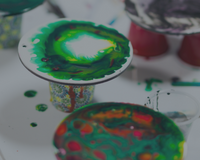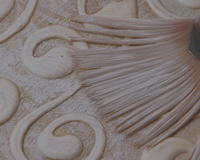Trying to find two-part epoxy resin to coat your painting? Just wait a minute right there...
There isn't anything much more satisfying than the look of a thick crystal clear coat of epoxy resin on your painting. It is incredibly appealing and tempting to coat all your paintings in epoxy resin, however they have very low UV stability compared to acrylic polymer emulsion products. Yes it's true, some epoxy resin products have better UV stability than others, but the bottom-line is all epoxy resin will yellow, it just depends on how much time has passed.
This should serve as a warning to all artists currently working with epoxy resin products that are selling their paintings - the last thing you want is a nasty call from a customer complaining about the painting they bought that is no longer as vibrant as it was when they purchased the piece.
There is a solution, and a good alternative. If you have shopped with us you are more than likely very familiar with Liquid Glass already. Liquid Glass is a product that was originally formulated for the acrylic pouring community. Liquid Glass has quickly been adopted by many artists' practices around the world for its uniquely smooth, crystal clear finish while being a 100% acrylic polymer emulsion product with complete UV stability - that means no yellowing ever.
Here are our tips for creating a wonderful piece no matter your project:
- If adding colour to the medium, use our professional quality or similar quality Liquid Acrylic, additions should be around 5% acrylic colour to pouring medium. Avoid high-viscosity paints. You may have to add more with a less pigmented paint, but this will not be ideal. Make sure the paint you mix into it is a 100% acrylic polymer emulsion product.
- Work on wood panel, aluminum panel, or a good quality canvas and stretcher frame. Canvas may sag so you can support it underneath with cardboard to keep things level.
- Avoid Masonite boards or bamboo boards, the glue in these products like to react chemically with the pouring medium on top, and can cause crazing and bubbles to appear.
- Avoid applying as a top coat over watercolours, or any product that is water-resoluble. This includes paint products containing PVAs, some re-soluble glues, some spray paints and spray paint varnishes, and some alcohol ink products.
- Avoid mixing with “zinc mixing white”. Zinc mixing white pigment may cause cracking to occur as it disrupts the polymerization process of this acrylic product.
- If looking for an overall glossy finish, use only glossy pigments, some pigments are naturally more matte than others.
- If you wish to use the product as a top coat, ensure that the paint underneath has fully cured before applying a layer of Liquid Glass. By pouring liquid glass before the acrylics underneath have fully cured, it can cause bubbling within the Liquid Glass as the layers underneath try to cure and release volatiles. I would recommend probably 72 hours.
Happy painting!



